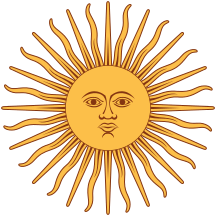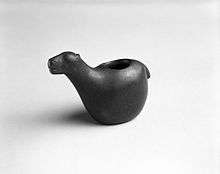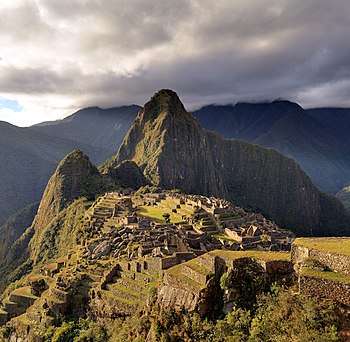Religion in the Inca Empire
In the heterogeneous Inca Empire, polytheistic religions were practiced. Some deities, such as Pachamama and Viracocha, were known throughout the empire, while others were localised.
Deities

Inca deities occupied the three realms:
- hanan pacha, the celestial realm in the sky.
- ukhu pacha, the inner earth realm.
- kay pacha, the outer earth realm, where humans live.
Deities of the Official Pantheon
- Viracocha:[1] He was typically seen as a white male human and known as the creator of humanity and everything else in the world.[2] In Inca Water Worship and Religion, it states, "He created humanity on an island in Lake Titicaca on the border between modern Peru and Bolivia and taught people how to live, assigning them tribal dress and customs and determining where they should live."[3] After this occurred, Viracocha gave control over humanity to lower gods then disappeared. When the Spaniards came to the Inca territory, the Inca thought they were god like because of their similarities in appearance with Viracocha.[2]
.jpg) Viracocha depicted in the wall as a man
Viracocha depicted in the wall as a man - Inti: Inti was one of the most important gods to the Inca people and known as the sun god. He is typically viewed as a boy from the Inca society and was also known as a golden disk with fire like rays coming and a face in the middle.[2][4] The Inca believed the sun was a key element for agriculture by protecting and helping with the growth of their crops.[4] The temple dedicated to Inti was the Coricancha[1] (a.k.a. The Golden Enclosure), which was one of the most important temples for the Inca people.[3] Inside Coricancha was a miniature field of corn and the corn was made out of gold. Annually, the emperor would "farm" this as a tradition.[2] Viracocha did not start out as the top deity in Inca religion, Inti was the first original and most powerful god. The transition from Inti to Virachocha has a couple of theories including: 1. The Inca society and people developed intellectually and started to question Inti's power. They questioned why an all powerful god did the same thing everyday.[2] 2. The society moved forward and they started going more towards monotheism (one god ruled over everything else, not that there was only one god). Since Viracocha was seen as a human, they saw this as being more powerful.[2]
- Illapa (Inti-Illapa): The name of this god means thunder and controls things like weather, rain, and lightning.[5] The Inca valued this god because Illapa was in control of the weather and the growth of their crops.[2] Many of the Inca society saw the image of this deity as a man wearing a sling.[4][5] Every time that Illapa would use the sling it would create the thunder heard by the Inca people.[2][4]
- Mamaquilla (Kilyamama[2]): The name of this god in the Inca language can be translated into Mother Moon.[5] All of the Inca society recognized this deity as female and was also seen as a silver disk with a face in the middle.[2] She was the wife of the deity Inti and was also in control of calendars.[4][5] This god was in charge of calendars because of the moons cycle which the Inca could track. All the temples that worshiped Mamaquilla were worked on by priestesses.[5]
- Pachamama: The name of this god translates to Earth Mother and is known as a female among the Inca society.[5] The Inca saw her as a protector of their crops/fields and a god of fertility to help their crops grow.[5]
- Mamacocha: The meaning of this gods name from the Inca language is Mother of Lakes and is widely known as a female.[5] The job of this deity is to keep the world strong and provide sources of water.[5]
- Stella Deities: These are deities formed using constellations or other cosmology features and are mostly believed to be of animals or activities.[3] In the book Inca Water Worship and Religion, an example would be "Urcuchillay, which is known to western astronomers as Lira, [who] was thought to protect llamas and alpacas."[3]
- Huacas[1]: Anything, including people, places, and objects, in the world that the Inca believed had a supernatural spirit, were called Huacas.[3] The size of the Huaca determined how much power it had. For example, mountains were considered some of the more powerful Huacas. The Inca worshiped and cared for them similar to the other deities.[3]
Household gods

In addition to the communally worshiped deities, Incan families sometimes worshiped household gods via their representation as miniature figurines most commonly referred to as chancas or conopas.[6] Conopa were often natural or carved stone objects that resembled crops or livestock, such as zarap conopa for maize, papap conopa for potatoes and caullama for llamas.[7][8]
Origin
Many ancient Andean peoples traced their origins to ancestral deities. Multiple clans could share similar ancestral origins. The Inca claimed descent from the Sun and the Moon, their Father and Mother. Many clans claimed descent from early proto-humans that emerged from local sites in nature called pacarinas.
The earliest ancestors of the Inca were known as Ayar, the first of which was Manco Capac or Ayar Manco. Inca mythology tells of his travels, in which he and the Ayar shaped and marked the land and introduced the cultivation of maize.
Religious expansion
Religious traditions in the Andes tended to vary among different ayllus. While the Inca generally allowed or even incorporated local deities and heroes of the ayllus they conquered, they did bring their gods to those peoples by incorporating them in law such as required sacrifice. The Inca attempted to combine their deities with conquered ones in ways that raised the status of their own. One example of this is Pachamama, the goddess of Earth, who was worshiped long before the rise of the Inca. In the Inca mythology Pachamama having been integrated was placed below the Moon who the Inca believed ruled over all female gods.[9]
Duality
A theme in Inca mythology is the duality of the Cosmos. The realms were separated into the upper and lower realms, the hanan pacha and the ukhu pacha and urin pacha. Hanan pacha, the upper world, consisted of the deities of the sun, moon, stars, rainbow, and lightning while ukhu pacha and urin pacha were the realms of Pachamama, the earth mother, and the ancestors and heroes of the Inca or other ayllus. Kay pacha, the realm of the outer earth, where humans resided was viewed as an intermediary realm between hanan pacha and ukhu pacha. The realms were represented by the condor (upper world), puma (outer earth) and snake (inner earth).
Sacred sites or things named wak'a were spread around the Inca Empire. In Andean mythology a wak'a was a deific entity which resided in natural objects such as mountains, boulders, streams, battle fields, other meeting places, and any type of place that was connected with past Incan rulers. A wak'a could also be an inanimate object such as pottery which was believed to be a deity-carrying vessel. Spiritual leaders in a community would use prayer and offerings to communicate with a wak'a for advice or assistance. Human sacrifice was part of Incan rituals in which they usually sacrificed a child (qhapaq hucha) or a slave. The Incan people thought it was an honor to die as an offering.
Archaeological remains confirm such human sacrificial practices, according to Reinhard and Ceruti: "Archaeological evidence found on distant mountain summits has established that the burial of offerings was a common practice among the Incas and that human sacrifice took place at several of the sites. The excellent preservation of the bodies and other material in the cold and dry environment of the high Andes provides revealing details about the rituals that were performed at these ceremonial complexes."[10]
Divination
The Incas also used divination. Divination was used to inform people in the city of social events, predict battle outcomes, and ask for metaphysical intervention.
Divination was essential before taking any action. Nearly every religious rite was accompanied by sacrifices. These were usually maize beer, food or llamas, but were occasionally of virgins or children. [11]
Divination was an important part of Inca religion, as reflected in the following quote:
The native elements are more obvious in the case of the sunrise divination. Apachetas, coca and the sun were major elements in pre-Conquest religion, and divination, the worship of sacred mountains and the bringing retribution against enemies were important ritual practices.[12]:292–314
Mummification
The rulers of the Inca empire, such as the last united Inca ruler Huayna Capac, were often mummified upon the time of their death, allowing for their bodies to be worshipped within the palaces.These worshipping events were intercepted by the Spaniards under Juan Polo de Ondegardo y Zárate, who was newly appointed as the Chief Magistrate of Cuzco in 1559, when it was under Spanish control. Ondegardo conducted a massive effort to prevent the Inca from committing their “idolatrous sins”, mainly by locating the mummified bodies of late Inca kings and sending them to the viceroy in Lima.[13] They remained in a hospital for around 80 years before their whereabouts became unknown.The Inca used to mummify their kings and several times a year they would be aligned in accordance to when they chronologically ruled in Cuzco’s plaza for the public to pay their respects.[14] In the other parts of the year, the mummies were returned to the Cuzco palaces and were worshipped privately by groups of visitors. Francisco Pizarro stated that “It was customary for the dead to visit one another, and they held great dances and debaucheries, and sometimes the dead went to the house of the living, and sometimes the living came to the house of the dead”.[13] The kings were thought to have been able to speak back to the worshippers through the use of oracles, and even gave advice to the protection and ruling of the land. The ruling Inca was expected to seek advice from the mummies of his ancestors for important issues. Not all Inca mummies were glorified, however, as in one case Topa Inca Yupanqui’s mummified body was torched and his bloodline all killed as they sided with Huascar in the civil war.[13]
Upon the arrival of the Spanish, the Inca started to hide the bodies of the kings and become more secretive with their worship, as stated by Juan de Betanzos. After being appointed, Polo do Ondegardo and his men found most of the mummified kings and took their bodies along with other ritualistic items such as their huaques, or their statues. A popular thought is that Ondegardo had the bodies buried in or around Cuzco in secret so that they would not be uncovered and worshipped again. Garcilaso de la Vega visited Ondegardo’s house and was shown an assembly of embalmed kings and attested to the degree of their preservation: “The bodies were perfectly preserved without the loss of hair of the head or brow or an eyelash. They were dressed as if they had been in life, with Ilautus (royal headbands) on their heads… their hands were crossed across their breast.”. The mummies were afterwards sent to the viceroy for him to see them and then afterwards they were brought back to Cuzco and thought to be secretly buried.The viceroy stored the mummies in the Hospital of San Andres in Lima because he was “a major benefactor of it”. Since the hospital was solely for the Spanish residents, they were likely on display for the citizens to view, away from the natives.[13]
Festivals


The Inca calendar had 12 months of 30 days, with each month having its own festival, and a five-day feast at the end, before the new year began. The Incan year started in December, and began with Qhapaq Raymi, the magnificent festival.[15]
| Gregorian month | Inca month | Translation |
|---|---|---|
| January | Camay | Fasting and Penitence |
| February | Hatun-pucuy | Great Ripening |
| March | Pacha-puchuy | Earth Ripening |
| April | Ayrihua or Camay Inca Raymi | Festival of the Inca |
| May | Aymoray qu or Hatun Cuzqui | Harvesting |
| June | Inti Raymi | Feast of the Sun and the great festival in honour of the sun for the harvest |
| July | Chahua-huarquiz, Chacra Ricuichi or Chacra Cona | The Harvest Festival |
| August | Yapaquis, Chacra Ayaqui or Capac Siquis | Sowing month |
| September | Coya Raymi and Citua | Festival of the Moon |
| October | K'antaray or Uma Raymi | Month of crop watching |
| November | Ayamarca | Festival of the dead |
| December | Capac Raymi | Magnificent festival |
See also
References
- 1 2 3 1532-1592., Sarmiento de Gamboa, Pedro, (2007). The history of the Incas. Bauer, Brian S., Smith-Oka, Vania, 1975- (1st ed.). Austin: University of Texas Press. ISBN 9780292714137. OCLC 156911932.
- 1 2 3 4 5 6 7 8 9 10 Gods, goddesses, and mythology. Littleton, C. Scott. New York: Marshall Cavendish. 2005. ISBN 0761475656. OCLC 708564500.
- 1 2 3 4 5 6 Gibaja Oviedo, Arminda M.; et al. (2016). Inca Water Worship and Religion. Reston, VA: American Society of Civil Engineers. pp. 11–17. ISBN 9780784414163.
- 1 2 3 4 5 Greg., Roza, (2008). Incan mythology and other myths of the Andes (1st ed.). New York: Rosen Central. ISBN 1404207392. OCLC 62805010.
- 1 2 3 4 5 6 7 8 9 N.,, D'Altroy, Terence (2002). The Incas. Malden, Mass.: Blackwell. ISBN 1405116765. OCLC 46449340.
- ↑ Kenneth Mills (2012). "Chancas and Conopas". Idolatry and Its Enemies: Colonial Andean Religion and Extirpation, 1640-1750. Princeton University Press. pp. 75–100. ISBN 9780691155487.
- ↑ Andrew James Hamilton (2018). Scale and the Incas. Princeton University Press. pp. 60–63. ISBN 9781400890194.
- ↑ Pablo Joseph de Arriaga (2015) [1621]. Extirpacion de l'Idolatría en el Perú [The Extirpation of Idolatry in Peru]. Translated by L. Clark Keating. University Press of Kentucky. pp. 28–30. ISBN 9780813163338.
- ↑ Steele, Paul Richar d (2004). Handbook of World Mythology. ABC-CLIO. ISBN 978-1576073544.
- ↑ Reinhard, Johan; Ceruti, Constanza (2005). "Sacred Mountains, Ceremonial Sites, and Human Sacrifice Among the Incas". Archaeoastronomy: The Journal of Astronomy in Culture. 19: 2. ISSN 0190-9940.
- ↑ Eerdman's Handbook to the World's Religions, 1982, Lion Publishing, Herts, England, page 55
- ↑ Rowe, John H. (1946). Julian H. Steward, ed. Handbook of South American Indians Vol. 2 The Andean Civilizations (PDF). Washington: Smithsonian Institution. pp. 183–330.
- 1 2 3 4 Bauer, Brian S.; Rodriguez, Antonio C. (2007). "The Hospital of San Andrés (Lima, Peru) and the Search for the Royal Mummies of the Incas". Fieldiana Anthropology. 39: 1–31.
- ↑ Palma, Ricardo (2004). Peruvian Traditions. Oxford, England: Oxford University Press.
- ↑ Kendall, Ann (1989). Everyday life of the Incas. New York: Dorset Press. ISBN 9780880293501.
External links
- Inca Religion - Ancient History Encyclopedia
- "Inca Religion", Elliott Shaw (General Editor), Overview of World Religions, PHILTAR, University of Cumbria
